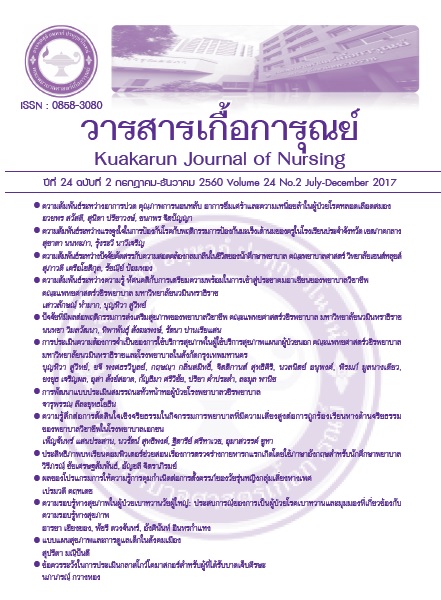ความสัมพันธ์ระหว่างแรงจูงใจในการป้องกันโรคกับพฤติกรรมการป้องกัน มะเร็งเต้านมของครูในโรงเรียนประจำจังหวัด เขตภาคกลาง
คำสำคัญ:
พฤติกรรมการป้องกัน, มะเร็งเต้านมบทคัดย่อ
Abstract
The correlation research aimed to study breast cancer prevention behaviors, perceived severity of breast cancer, perceived susceptibility of breast cancer,
response efficacy toward breast cancer prevention behaviors, self-efficacy expectation of breast cancer prevention behavior and the factors related to
studying breast cancer prevention behaviors among female teachers in provincial schools in the Central region. The study was conducted by random sampling with 365 female aged 25 - 59 years old. The female teachers taught in 5 schools. The research instruments consisted of six parts: (1) demographic data; (2) perceived severity of breast cancer; (3) perceived susceptibility of breast cancer; (4) response efficacy toward breast cancer prevention behaviors; (5) self-efficacy expectation of breast cancer; and (6) breast cancer prevention behavior. Content validity was examined by five experts and reliability was tested using Cronbach’s alpha coefficient obtained at 0.77, 0.90, 0.80, 0.92 and 0.91 respectively. Pearson’s product moment correlation was used in statistical analysis. The results of the study revealed that the breast cancer prevention behavior among female teachers in provincial schools, in the Central
region was at medium level (x =3.42, SD = 0.62) and perception of the severity, susceptibility of breast cancer, response efficacy toward breast cancer prevention behaviors, self-efficacy expectation of breast cancer were positively related to breast cancer prevention behavior among female teachers in provincial schools, central region at the level of 0.05 (r = 0.13, r = 0.13, r = 0.26, r = 0.16, respectively)
เอกสารอ้างอิง
ณภัทรอร สุขมา. (2549). ปัจจัยที่มีผลต่อพฤติกรรมการป้องกันมะเร็งเต้านมของสตรีที่ทำงานในโรงงานเขตนิคมอุสาหกรรม จังหวัดสมุทรสาคร (วิทยานิพนธ์ปริญญามหาบัณฑิต). มหาวิทยาลัยคริสเตียน, นครปฐม.
ดาริน โต๊ะกานิ, บุญยิ่ง ทองคุปต์ และประดังพร ทุมมาลา. (2552). ปัจจัยที่มีอิทธิพลต่อพฤติกรรมการตรวจเต้านมด้วยตนเองของสตรีที่มารับบริการในคลินิกวัยทองของโรงพยาบาลในสามจังหวัดชายแดนภาคใต้. วารสารมหาวิทยาลัยนราธิวาสราชนครินทร์, 1(1).
นนทรี สัจจาธรร และ ณฐินี พงศ์ไพฑูรย์สิน. (2555). ปัจจัยทีมีความสัมพันธ์ต่อพฤติกรรมการดูแลสุขภาพและการใช้บริการสาธารณสุขของครูมัธยมศึกษา จังหวัดนนทบุรี (รายงานวิจัย).
กรุงเทพฯ วิทยาลัยราชพฤกษ์.
บุญชม ศรีสะอาด. (2556). การวิจัยเบื้องต้น (ฉบับปรับปรุงใหม่). กรุงเทพฯ: สุวีริยาสาส์น.
ปริญดา ทุนคำ. (2541). การประยุกต์ทฤษฏีแรงจูงใจในการป้องกันโรคเพื่อส่งเสริมพฤติกรรมการตรวจเต้านมด้วยตนเองของนักเรียนหญิง สถาบันราชภัฏนครสวรรค์ (วิทยานิพนธ์ปริญญา
วิทยาศาสตรมหาบัณฑิต). มหาวิทยาลัยมหิดล, กรุงเทพฯ.
พัฒน์พงศ์ นาวีเจริญ. (2552). ก้อนในเต้านม. (พิมพ์ครั้งที่ 3). กรุงเทพฯ: อมรินทร์สุขภาพ.
เพ็ญพิศ จีระภา. (2554). แรงจูงใจในการตรวจเต้านมด้วยตนเองของสตรี อำเภอเมือง จังหวัดชุมพร. วารสาร มหาวิทยาลัย ราชภัฏ ยะ ลา, 6(2), 104-112.
สุกิจ โตสงค์. (2553). พฤติกรรมการดูแลสุขภาพตนเองของข้าราชการครูจังหวัดมุกดาหารที่ตรวจสุขภาพ: ประจำปี 2553 (รายงานวิจัย). ศูนย์อนามัยที่ 7 อุบลราชธานี.
เอมอร ชินพัฒนะพงศา. (2552). การศึกษาความสัมพันธ์ระหว่างการรับรู้ประโยชน์ การรับรู้อุปสรรคและการรับรู้ความสามารถกับพฤติกรรมการตรวจเต้านมตนเองของนักศึกษาพยาบาล.
วารสารพยาบาลสาธารณสุข, 28(1), 14-29.
National Cancer Institute. (2011). Hospital-based Cancer Registry. Nontaburi: Ministryof Public Health.
National Cancer Institute. (2013). What is prevention. Retrieved January 5, 2014, from http://www.cancer.gov/cancertopics/pdq/ prevention/breast/Patient.
Plotnikoff, R. C. & Higginbotham, N. (2010). Protection motivation theory and exercise behavior change for the prevention of heart disease in a high-risk, Australian
representative community sample of adults. Psychology, Health & Medicine, 7(1), 87-98.
Rogers, P. W. (1975). A protection motivation theory of fear appeals and attitude change. Journal of Psychology. 91(1), pp. 93-114.
World Health Organization.(2013). Cancer prevention. Retrieved March 5, 2014, fromhttp://www.who.int/cancer/prevention/en/_.















